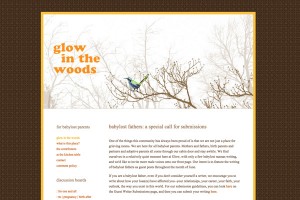This article was first published in the Autumn 2014 issue of Bearings Magazine, a semi-annual publication of the Collegeville Institute.
We who wander the Internet wailing have created our own culture around death, our own rituals of mourning. An angel writes our baby’s name in the sand across the world. We write poetry. We light candles together. We trade skulls and hearts and ornaments.
 In the wake of her daughter’s death, a mother who goes by “Sara” on Internet forums blogs these words at Glow in the Woods, an online community for parents who have lost babies to stillbirth or infant death. Sara is part of a group of bereaved mothers and fathers who turn to the Internet to find connection in the midst of the social alienation that often accompanies tragedy. Sara and other parents who visit sites like Glow in the Woods participate to discover companionship in emotional pain, process difficult emotions, find and make meaning in the midst of tragedy, and preserve the memory of their babies. As Sara’s words illustrate, forums like Glow in the Woods help bereaved parents reconstruct their lives in the wake of loss.
In the wake of her daughter’s death, a mother who goes by “Sara” on Internet forums blogs these words at Glow in the Woods, an online community for parents who have lost babies to stillbirth or infant death. Sara is part of a group of bereaved mothers and fathers who turn to the Internet to find connection in the midst of the social alienation that often accompanies tragedy. Sara and other parents who visit sites like Glow in the Woods participate to discover companionship in emotional pain, process difficult emotions, find and make meaning in the midst of tragedy, and preserve the memory of their babies. As Sara’s words illustrate, forums like Glow in the Woods help bereaved parents reconstruct their lives in the wake of loss.
Online communities like Glow in the Woods often become religious spaces, even though they may have been designed as non-sectarian, pluralistic, or even secular.
Stillbirth and neonatal death often trigger immense and long-lasting grief in parents. These life-altering losses both call upon and call into question parents’ religious beliefs and practices. Thus, online communities like Glow in the Woods often become religious spaces, even though they may have been designed as non-sectarian, pluralistic, or even secular. Attempting to illuminate the impact of stillbirth and neonatal death on parents’ religion as it is expressed online, we conducted a study of the blog entries of bereaved parents. We chose Glow in the Woods because it is a hub site for such parents. It is first in its category in blog search engines. We compiled and analyzed a sample of over 250 entries that reflected religious content.
We found four major themes in these entries: religious disorientation, religious reorientation, changed relationships with others, and a quest for meaning. We discuss these themes in “Bereavement and Religion Online: Stillbirth, Neonatal Loss, and Parental Religiosity,” an article published by the Journal for the Scientific Study of Religion in 2013. Here, we can say briefly that a number of parents described crisis or disturbances in their religious lives after their baby’s death. Many identified a constructive element in their process of religious struggle as well. Some parents described a reorientation of their faith over time, a new way of being spiritual and of relating to transcendent reality that felt more stable, either with less anger and fewer doubts, or more capable of incorporating anger and doubt. As parents sought to integrate loss into their lives, many articulated a religious quest for meaning and purpose—either related to the baby, the traumatic experience of the baby’s death, or their own ongoing life. This process of reorienting their religious lives and/or engaging in a religious quest for meaning in the wake of loss was contextualized and complicated by both interpersonal relationships and religious communities. Some parents described altered relationships with others based on religious themes.
As Sara’s quote reveals, parents who are active on Glow in the Woods help each other ritualize, commemorate, and make meaning of their babies’ lives and deaths.
Glow in the Woods not only helps users navigate religious questions and deal with relationships in face-to-face religious communities, it also functions as a religious community in its own right. As Sara’s quote reveals, parents who are active on Glow in the Woods help each other ritualize, commemorate, and make meaning of their babies’ lives and deaths. Disaffected to one degree or another from religious institutions, whether because of their loss or for other reasons, many Glow in the Woods participants look to the site as a resource for developing practices of remembrance, as well as paradigms of meaning. Among both the religiously affiliated and the unaffiliated, Glow in the Woods provides a religious support system for those who share the experience of loss.
Religion online is a nontraditional but important social context for grief, especially regarding such statistically rare tragedies as stillbirth and neonatal death. By legitimating and shaping social expressions of grief, online forums like Glow in the Woods build solidarity among a population marginalized by loss. They create a culture of empathy buttressed by the at-once anonymous and intimate character of many online communities. The Internet allows parents to meet others with similar losses, to find affirmation and safety, and to share coping strategies. Additionally, the Internet provides space for processing offline relationships, especially difficult ones. Sites such as Glow in the Woods are safe for expressing anger and rage in an environment where validation and support are predictable responses.
Glow in the Woods attracts religiously affiliated individuals from a variety of traditions, as well as unaffiliated individuals, including atheists, agnostics, and those who describe themselves as “spiritual but not religious.” Rather than sidelining religion or featuring pro/con religious debates as many pluralistic venues do, Glow in the Woods facilitates open-ended dialogue about such religious topics as theodicy, determinism, human value, and life after death. While Glow in the Woods participants differ on many scores, their shared cultural assumptions about health, control, justice, and the exceptional nature of their experience give them a common platform for processing the far-reaching implications of the loss of a baby. At Glow in the Woods, participants from a variety of religious backgrounds compare their traditions’ teachings and practices related to suffering, death, and grief. Lines between traditions are often blurred as participants personalize and reinterpret traditional teachings and practices, borrowing from each others’ language and ideas.
As the religious activity taking place on sites like Glow in the Woods illustrates, the Internet is helping to reshape religious affiliation and identity.
For most of us, sites like Glow in the Woods do not readily come to mind when we think of “religious community” or “inter-religious dialogue.” Historically, religious community has been linked with institutions—institutions with leaders, buildings, doctrines, and rules. Inter-religious dialogue, too, has often been considered institutional territory. “Official” representatives of discreet religious organizations gather in boardrooms to compare “official” teachings or draft “official” referenda. But as the religious activity taking place on sites like Glow in the Woods illustrates, the Internet is helping to reshape religious affiliation and identity. On their own terms, in their own voices, and through their own means, parents like Sara engage with religion and spirituality in the social context of the Internet.
For Sara and many other people, the Internet is a place to find and make meaning out of tragedy. Sara grew up Catholic, but drifted away from the church as a teen. After majoring in religion in college, she adopted various Buddhist teachings and practices. Now, in the wake of her daughter’s death, Sara struggles with her religious identity. She resonates with Buddhist conceptions of impermanence and suffering, but she finds the notion of karma distasteful and she cannot let go of the idea that her daughter has a personal soul. She considers Catholicism legalistic and circumscribed, but she yearns to recreate the religious rituals she experienced as a child at Día de los Muertos and Easter Vigil commemorations. Sara paints, meditates, writes, takes photos, and sculpts—each practice an avenue to express her grief. She shares the fruits of these practices with a community of bereaved parents at Glow in the Woods. Other parents do the same. On the first anniversary of Sara’s daughter’s birth and death, an Australian woman named Maggie writes the name of Sara’s daughter in the sand of Cable Beach at sunset, and shares a digital photo of the scene online. This act is not religious in the traditional sense. But for Sara, Maggie is an “angel,” name-writing is a ritual, and the Internet is church.
Like this post? Subscribe to have new posts sent to you by email the same day they are posted.




Leave a Reply